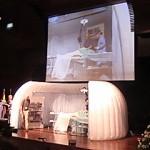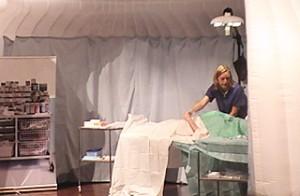Monday August 31st, 2009: In this fascinating Large Group Session Dr Roger Kneebone and colleagues from Imperial College, London, drew large crowds for a demonstration of their new distributive simulation suite.
 At the start of this session Dr Kneebone set the scene, outlining the requirement for heightened reality in simulations whilst maintaining the balance between imaginative engagement and realism, and also the importance of striking the correct balance between the learner and patient focus.
At the start of this session Dr Kneebone set the scene, outlining the requirement for heightened reality in simulations whilst maintaining the balance between imaginative engagement and realism, and also the importance of striking the correct balance between the learner and patient focus.
When creating simulated clinical scenarios, there are many factors to consider: how do you escape the hegemony of technology? That is, how can you recreate real-life situations with external factors such as anxious patients and outside distractions? After all, clinical scenarios are often complex environments, and in reality the patient’s needs will supersede those of the learner.
Another pertinent issue was that of accessibility. Dr Kneebone explained that although state-of-the-art simulations suites are undoubtedly of value to the learners, they are extremely expensive and not all medical and healthcare students will have access to these resources.
This was followed by a live demonstration of their new Distributive Simulation, a portable simulator (the ‘room’ was inflatable, effectively blocking out the surrounding environment) which was designed to include enough salient features of the clinical setting to make the experience realistic, whilst remaining affordable and accessible.
 The scenario that was presented was a patient who was deteriorating, but who was conscious and needed a central line. The actor playing the patient wore a prosthetic neck whereby the doctor could insert the central line. The procedure was performed by a doctor and assisted by a nurse. After the demonstration, the participants shared their experience with the session attendees.
The scenario that was presented was a patient who was deteriorating, but who was conscious and needed a central line. The actor playing the patient wore a prosthetic neck whereby the doctor could insert the central line. The procedure was performed by a doctor and assisted by a nurse. After the demonstration, the participants shared their experience with the session attendees.
“It was like a real medical scenario and I just wanted to do the best for my patient,” commented one participant.“It’s very realistic, having the patient there moving around, and I had to calm her down” said another.
Although this distributive simulation suite is still in the research stages, already it is showing great potential in developing effective, realistic and accessible simulated clinical scenarios.
Listen to Dr Rachel Ellaway from the Northern Ontario School of Medicine in Canada talk about her reaction to this demonstration here:
